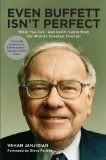 I managed to snag a copy of Even Buffett Isn’t Perfect
I managed to snag a copy of Even Buffett Isn’t Perfect from the local library the past weekend. I’m only halfway through it, but it has set me thinking about quite a few issues. Basically the book is about some of the inconsistencies and flip-flops Buffett has made over the many years he has pontificated on value investing. I’ll just highlight a couple here that has struck me as relevant to small value investors.
Buffett has often pooh-poofed the idea that diversification decreases risk, and has repeatedly stated that risk is abolished by deep knowledge about the company and the industry. Professional value investors range from an ultra-concentrated style (fewer than 10 stocks, with large positions comprising 25% of portfolio or more, notable practitioners include Eddie Lampert and Tom Brown), to the concentrated 10-stock model (popularized by Monish Pabrai), to the traditional moderately diversified 20-stock model (Bill Miller and pretty much the rest of the value investor universe). I think that small investors without billions to invest should be able to choose from a far larger universe of stocks than Buffett is able to, therefore small investors should always be reasonably diversified. I frequently come across ideas not worthy of large position sizes, and in the past has just passed on them. But recently, I am beginning to think that many small positions in the aggregate may provide a beneficial boost to my return, as long as each individual small position has a reasonable margin of safety. (Given the recent disastrous disintegration of one of my oversized positions, I am only being wise after the fact here.) Interestingly, Buffett has recently been touting the advantages of index funds for retail investors, which of course is the ultimate in diversification.
Buffett has also typically frowned upon high turnover in a portfolio. The typical argument is that high turnover runs up transaction costs and is tax-inefficient. With the discount brokers today, transaction costs are insignificant even for a portfolio of several thousand dollars. If one has a 20-position portfolio and holds each position for slightly more than one year to gain preferential tax treatment, that implies a turnover rate of 1-2 per month. I think that as long as high quality ideas can be found, high turnover need not necessarily reflect bad investing habits. The value of turnover in cutting one’s losses from the inevitable mistakes, and in maximizing return by constantly replacing stocks approaching their intrinsic value with more undervalued ones, should not be underestimated. Buffett, of course, does not have the luxury of high turnover. Given his capitalization, he cannot simply exit one of his positions on a whim and wait for a more advantageous price to re-enter. However, he does have the luxury of calling up the CEO and demanding a change in strategy, or just stepping in and managing the company himself (as he has done on rare occasions, most notably at Salomon). Large and small investors have different sets of advantages. The ability to enter and exit positions rapidly is an important advantage which should not be ignored.
I am only recently trying to put these ideas into practice, starting with increasing my portfolio to 20-30 positions, and stepping up the turnover. While I think this concept is theoretically attractive, in practice it is exhausting. Therefore, I’ll be grateful if you can toss me a few ideas to help me along.
